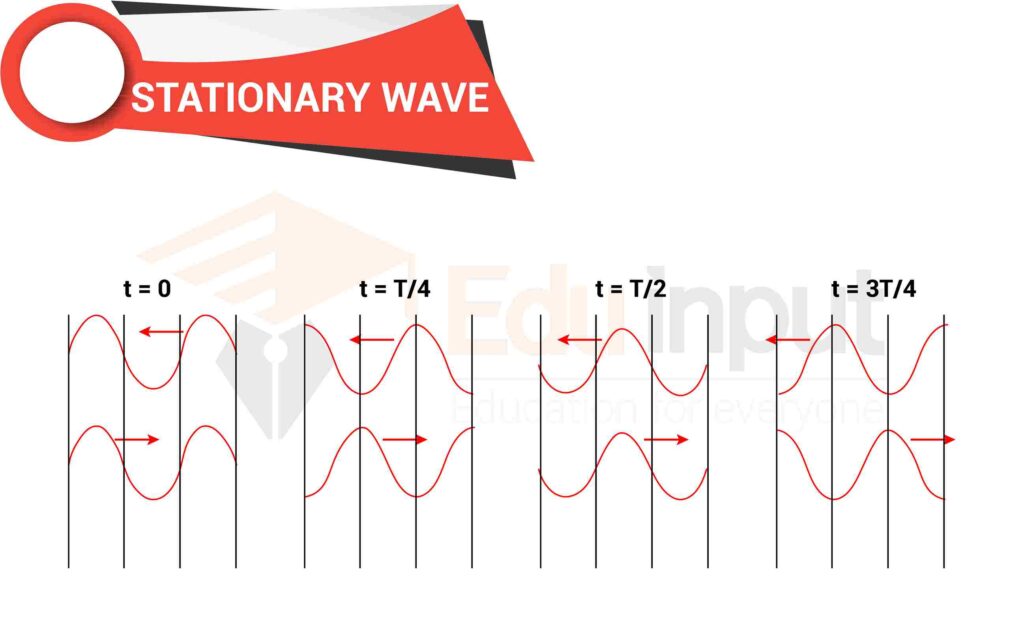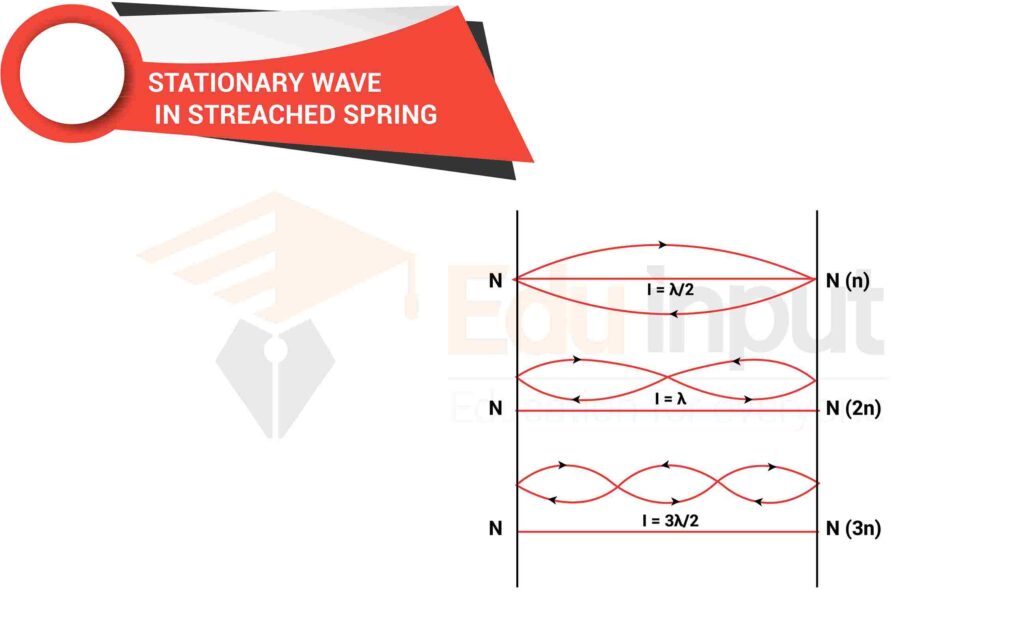Stationary Waves | Stationary waves in a stretched string
Stationary waves are defined as when two identical waves of equal frequency and traveling in the opposite direction, superpose each other, they form a special type of wave known as stationary or standing waves.
Stationary waves
Consider the superposition of two waves moving along a string in opposite directions. The figure shows such two waves at instant t=0, T/4, T/2, 3(T/4), and T.
Where T is the time period of the wave. We are interested in finding out the displacement of points 1, 2, 3, 4, 5, 6, and 7 at these instants as the waves superpose. The points 1, 2, 3, etc are distant T/4 apart from each other, where λ is the wavelength of the waves.
What are Nodes and Antinodes?
The resultant displacement at these points is calculated by using the principle of superposition. That the resultant displacement at points 1, 3, 5, and 7 is always zero at instants t=0, T/4, T/2 3(T/4), and T. These points are called nodes.

The points in the stationary waves where resultant displacement is zero are called nodes. The distance between two consecutive nodes is λ /2.
The resultant displacement of the points 2, 4, and 6 at the instants t=0, T/4, T/2, 3(T/4), and T. These points are moving with an amplitude which is the sum of the amplitudes of the component waves. These points are known as antinodes.
Such a pattern of nodes and antinodes is known as a stationary or standing wave.
- Distance between two consecutive nodes= λ /2
- Distance between two consecutive antinodes= λ /2 Distance between two consecutive nodes and antinodes = λ /4
Standing wave
Energy in a wave moves because of the motion of the particles of the medium. The nodes always remain at rest, so energy cannot flow past these points.
Hence energy remains standing in the medium between nodes. The energy alternates between potential and kinetic forms.
Potential Energy:
When the antinodes are all at their extreme positions, whole energy is potential.
Kinetic Energy:
When the antinodes are all at their equilibrium positions, the whole energy is kinetic.
Stationary waves in a stretched string
Stationary waves can easily be generated in a stretched string. Consider a string of length l which is kept stretched by clamping its ends so that the tension in the string is F. When the string is plucked and then released, two waves are generated which moves in opposite direction alone string.
Both of these are reflected back from clamped ends of the string with opposite phases. Two ends are clamped with red supports so they don’t vibrate and we get nodes at these points. The speed of the wave depends upon tension F in string and mass per unit length of m.
V=√f/m
For the First Mode of Vibration
When the string is plucked at the middle point the string vibrates in one loop. The nodes are formed at fixed ends and one antinode is formed between them. As the distance between consecutive nodes is always equal to λ/2
l=λ1/2
λ1=2l
But the speed V of the waves in the string is given by
V= √f/m
The speed of the wave is given by the relation.
V=f1 λ1
F1=v/ λ1=v/2l
f1=1/2l √f/m
This is the formula for the frequency of vibration of string for a single loop. This frequency is also called the fundamental frequency.
Speed of wave
The speed of waves depends upon tension and mass per unit length of the string. It is independent of the point from where the string is plucked to generate the waves. So the speed v of the waves will be the same in the two cases.
It is clear that as the string vibrates in more and more loops its frequency goes on increasing and the wavelength goes correspondingly shorter.
However, the product of the frequency and wavelength is always equal to .v the speed of waves.
v = f λ

For the Second Mode of Vibration
When the same string of length l is plucked from one-fourth of its length it vibrates in two loops with frequency f2
In this case, the wavelength λ2 is given by
l= λ2/2 + λ2/2
=2 λ2/2
λ2=2 l/2
The speed of the wave is given by
v=f2 λ2
f2=v/ λ2
f2=v/2l/2
=2(v/2l)
F2=2f1
For the Third Mode of Vibration
When the same string of length l is plucked at one-sixth (1/6th) of its length it vibrates in three loops. In this case, the wavelength is, λ3, and the frequency are f3.
l= λ3/2+ λ3/2+ λ3/2
=3 (λ3/2)
λ3=2( l/3)
V=f3 λ3
f3=v/ λ3 =v/2l/3
=3 (v/2l)
=3 (1/2l √f/m)
f3=3f1.
For the nth Mode of Vibration
The wavelength for an nth mode of vibration is given by λn=2l/n
The speed of the wave is given as.
The stationary has a set of frequencies n
V=fn λn
fn=V/ λn
fn= V/2l/n =n(V/2l) =n (1/2l √F/m)
=nf1
The stationary waves have a discrete set of frequencies f1, 2f1, 3f1 …. nf1 which is known as harmonic series.
The lowest frequency f1, for which the first mode of vibration is produced, is called the fundamental frequency.
Quantization of frequencies
Stationary waves of all frequencies cannot be set up in a medium. Only a discrete set of frequencies can set up waves in the medium. This is known as the quantization of frequencies. The frequency of a string on a musical instrument can be changed either by varying the tension or by changing the length. Once the instrument is tuned, the musicians vary the frequency by moving their fingers along the neck.







Leave a Reply